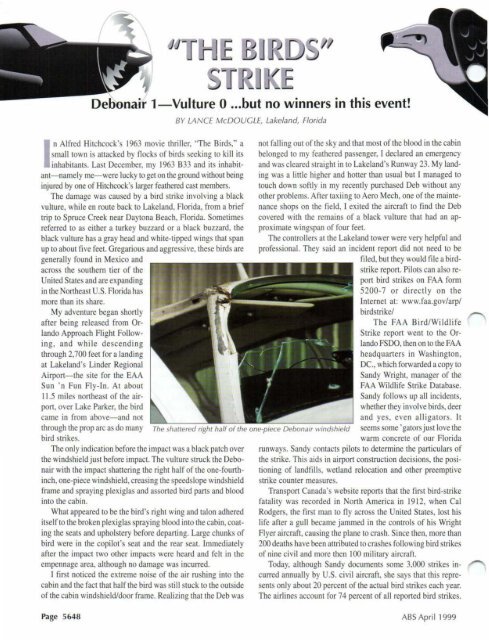April 1999 - American Bonanza Society
April 1999 - American Bonanza Society
April 1999 - American Bonanza Society
- No tags were found...
Create successful ePaper yourself
Turn your PDF publications into a flip-book with our unique Google optimized e-Paper software.
Debonair 1-Vulture 0 ... but no winners in this event!In Alfred Hitchcock's 1963 movie thriller, "The Birds," asmall town is attacked by flocks of birds seeking to kill itsinhabitants. Last December, my 1963 B33 and its inhabitant-namelyme-were lucky to get on the ground without beinginjured by one of Hitchcock's larger feathered cast members.The damage was caused by a bird strike involving a blackvulture, whi le en route back to Lakeland, Florida, from a brieftrip to Spruce Creek near Daytona Beach, Florida. Sometimesreferred to as eitber a turkey buzzard or a black buzzard, theblack vulture has a gray head and white-tipped wings that spanup to about five feet. Gregarious and aggressive, these birds aregenera lly found in Mexico andacross the southern tier of theUnited States and are expandingin the Northeast U.S. Florida hasmore than its share.My adventure began shortlyafter being released from OrlandoApproach Right Following,and while descendingthrough 2,700 feet for a landingat Lakeland's Linder RegionalAirport-the site for the EAASun ' n Fun Fly-In. At about11.5 miles northeast of the airport,over Lake Parker, the birdcarne in from above-and notthrough the prop arc as do manybird strikes.The only indication before the impact was a black patch overthe windshie ld just before impact. The vulture struck the Debonairwith the impact shattering the right half of the one-fourthinch,one-piece windshield, creasing the speedslope windshieldframe and spraying plexiglas and assorted bird parts and bloodinto the cabin.What appeared to be the bird's right wing and talon adhereditself to the broken plexiglas spraying blood into the cabin, coatingthe seats and upholstery before departing. Large chunks ofbird were in the copilot's seat and the rear seat. Immediatelyafter the impact two other impacts were heard and felt in theempennage area, although no damage was incurred.I first noticed the extreme noise of the air rushing into thecabin and the fact that half the bird was still stuck to the outsideof the cabin windshield/door frame. Realizing that the Deb wasBY LANCE McDOUGLE, Lakeland, FloridaThe shattered right hall 01 the one·piece Debonair windshieldnot falling out of the sky and that most of the blood in the cabinbelonged to my feathered passenger, I declared an emergencyand was cleared straight in to Lakeland's Runway 23. My landingwas a little higher and hotter than usual but I managed totouch down softly in my recently purchased Deb without anyother problems. After taxiing to Aero Mech , one of the maintenanceshops on the field , I exited the aircraft to find the Debcovered with the remains of a black vulture that had an approximatewingspan of four feet.The controllers at the Lakeland tower were very helpful andprofessional. They said an incident report did not need to befiled, bUllhey would fi le a birdstrikereport. Pilots can also reportbird strikes on FAA form5200· 7 or direct ly on theInternet at: www.faa.gov/arp/birdstrike/The FAA Bird/WildlifeStrike report went to the OrlandoFSDO, then on to the FAAheadquarters in WaShington,DC., which forwarded a copy toSandy Wright, manager of theFAA Wildlife Strike Database.Sandy follows up all incidents,whetherthey involve birds, deerand yes, even alligators. Itseems some' gators just love thewarm concrete of our Floridarunways. Sandy contacts pilots to determine the particulars ofthe strike. This aids in airport construction decisions, the posi·tioning of landfills, wetland relocation and other preemptivestrike counter measures.Transport Canada's website reports that the first bird-strikefata lity was recorded in North America in 1912, when CalRodgers, the first man to fly across the United States, lost hislife after a gull became jammed in the controls of his WrightFlyer aircraft, causing the plane to crash. Since then, more than200 deaths have been attributed to crashes following bird strikesof nine civi l and more then 100 military aircraft.Today, although Sandy documents some 3,000 strikes incurredannually by U.S. civil aircraft, she says that this repre·sents only about 20 percent of the actual bird strikes each year.The airlines account for 74 percent of all reported bird strikes.Page 5648ASS <strong>April</strong> <strong>1999</strong>
















